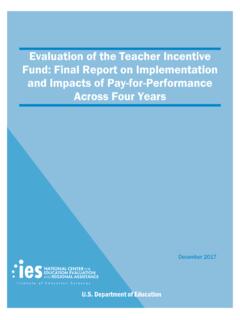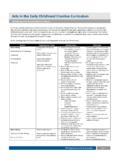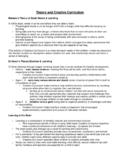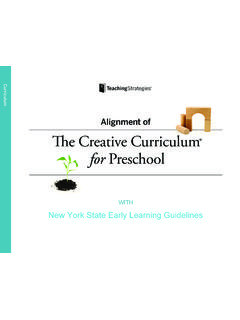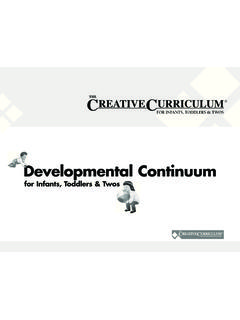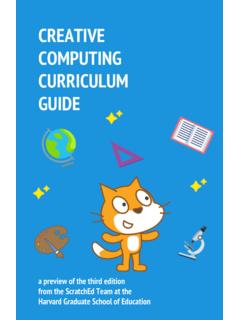Transcription of Chapter 2. Bright Beginnings and Creative Curriculum ...
1 41 Chapter 2. Bright Beginnings and Creative Curriculum : vanderbilt university ( tennessee site ) Curriculum The vanderbilt university ( tennessee ) researchers evaluated Bright Beginnings and Creative Bright Beginnings Bright Beginnings is an integrated Curriculum with a focus on language and early literacy. It is based in part on the High/Scope and Creative Curriculum models, with an added focus on literacy skills that are designed to promote school readiness. The Curriculum goals are to provide a child-centered, literacy-focused program that is consistent with developmentally appropriate practice and to include instruction that addresses the cognitive, social, emotional, and physical development of young children. The Curriculum was especially designed to provide continuity in the pre-kindergarten to second-grade curricula. Bright Beginnings includes nine Curriculum units that are linked to the program components: language and literacy; mathematics; social and personal development; healthful living; scientific thinking; social studies; Creative arts; physical development; and technology.
2 The classroom environment is designed to encourage children s active exploration and interaction with adults, other children, and classroom materials. Teachers conduct ongoing assessments of children as they engage in a range of classroom activities. The Curriculum also includes a Family-School Connection link. Parents sign a parent-school partnership agreement that requires a parent/caregiver to be actively engaged in the child s education. Creative Curriculum Creative Curriculum is a comprehensive Curriculum for 3- to 5-year-old children. The Curriculum addresses four areas of development: social/emotional; physical; cognitive; and language development. 1 The university of North Carolina at Charlotte research team also evaluated Creative Curriculum . Chapter 2. Bright Beginnings and Creative Curriculum : vanderbilt university ( tennessee site ) 42 Creative Curriculum requires the physical space of the classroom to be structured into 10 interest areas: blocks, dramatic play, toys and games, art, library, discovery, sand and water, music and movement, cooking, and computers.
3 Time is also allotted for outdoor activities. The 10 interest areas are designed to address Curriculum content, such as literacy, mathematics, science, social studies, the arts, technology, and process skills, such as observing, exploring, and problem solving. Creative Curriculum includes a Developmental Checklist teachers are asked to use in ongoing assessments of child progress. Sample The tennessee research team recruited 36 public pre-kindergarten classrooms in seven school districts in six different counties. All of the selected programs were full-day pre-kindergarten programs. Teachers were recruited in July of the preschool year, Curriculum training occurred in August, and parental consent was obtained in late August 2003 and early September 2003. A total of 36 teachers/classrooms and 558 parents and children were recruited for participation in the site -level study.
4 A subset of that sample (21 classrooms and teachers) including 309 children and 300 parents (103 in the Bright Beginnings treatment group, 101 in the Creative Curriculum treatment group, and 105 in the control group) were included in the PCER study sample. Data were collected on 309 children and 252 parents at the time of the fall baseline data collection. In the follow-up year of the evaluation, the sample of schools went from 19 preschools to 64 schools in kindergarten. The evaluation sample of classrooms went from 21 preschool to 134 kindergarten classrooms. The kindergarten sample included 307 children and 298 parents from the original sample of participants. Data were collected on 300 children and 232 parents. Children and Families The children were years old at the time of baseline data collection and slightly more than half (52%) were male. The sample of children was White (80%), African American (18%), and Hispanic (11%).
5 Table provides additional information on the demographic characteristics of the children in the study sample. At baseline, a higher percentage of control group parents reported that their child had an Individualized Education Plan (IEP) relative to those assigned to the Bright Beginnings and Creative Curriculum conditions (33% vs. 13% and 12%, p < .01). Table Child demographic characteristics for Bright Beginnings and Creative Curriculum Curriculum comparison Characteristics Full sample n = 309 Controln = 105 Treatment 11 n = 101 Treatment 22n = 103 Age at baseline (years), mean (% male) (%) White, non-Hispanic African American, non-Hispanic Hispanic Asian or Pacific Islander Native American Multiple/other Child disability status (parent reported, %) ** Reporting standards not met.
6 Values suppressed to protect participant confidentiality. ** p < .01 1 Treatment 1 is Creative Curriculum . 2 Treatment 2 is Bright Beginnings . SOURCE: PCER Parent Interview (Fall 2003, Spring 2004, and Spring 2005). Chapter 2. Bright Beginnings and Creative Curriculum : vanderbilt university ( tennessee site ) 43 The demographic characteristics of the primary caregivers, who were most often the biological or adoptive mother, are presented in table The average age of the primary caregiver was 31 years. More than half (65%) of the primary caregivers were married. Less than half reported having had some college (34%) or had graduated from college (7%), 38 percent had a high school diploma or GED, and 21 percent had not finished high school. Less than half (43%) of the primary caregivers were employed full-time, 13 percent were employed part-time, and 39 percent were unemployed.
7 There were no statistically detectable differences between the treatment and control groups on the primary caregiver characteristics. Table Primary caregiver demographic characteristics for Bright Beginnings and Creative Curriculum Curriculum comparison Characteristics Full sample n = 249 Control n = 78 Treatment 11 n = 78 Treatment 22n = 93 Age at baseline (years), mean status (%) Married Separated/Divorced Widowed Never Married (%) White, non-Hispanic African American, non-Hispanic Hispanic Asian or Pacific Islander Native American Multiple/other Educational level (%) Did not finish high school High school diploma or GED Some college College graduate 13 Employment (%) Full-time Part-time Unemployed Other Reporting standards not met.
8 Values suppressed to protect participant confidentiality. 1 Treatment 1 is Creative Curriculum . 2 Treatment 2 is Bright Beginnings . SOURCE: PCER Parent Interview (Fall 2003, Spring 2004, and Spring 2005). Chapter 2. Bright Beginnings and Creative Curriculum : vanderbilt university ( tennessee site ) 44 Teachers There were 21 teachers who participated in the preschool year intervention study. All of the teachers were female, and all were White. On average, the preschool teachers had 11 years of teaching experience, with an average of 6 years of experience teaching preschool. All of the teachers had a bachelor s (52%) or graduate (48%) degree. All reported having a state-awarded teacher certification. Table provides additional information on the characteristics of the preschool sample of teachers. There were no statistically detectable differences between the treatment and control groups on the teacher characteristics.
9 Table Preschool teacher characteristics for Bright Beginnings and Creative Curriculum Curriculum comparison Characteristics Full sample n = 21 Control n = 7 Treatment 11 n = 7 Treatment 22n = 7 Gender (% female) (%) White, non-Hispanic African American, non-Hispanic Hispanic Asian or Pacific Islander Native American Multiple/other level (%) High school diploma or GED Associate s degree Bachelor s degree Graduate degree Current teaching license/certificate (%) Development Associate (CDA) (%) preschool certificate (%) credential (%) of teaching experience, overall (mean) of preschool teaching experience (mean) Reporting standards not met.
10 Values suppressed to protect participant confidentiality. 1 Treatment 1 is Creative Curriculum . 2 Treatment 2 is Bright Beginnings . SOURCE: PCER Preschool Teacher Survey (Fall 2003 and Spring 2004). Programs/Classrooms The average preschool class size was children. The child-staff ratio was on average children to 1 teacher or program staff person. Random Assignment Randomization of 36 classrooms to the three Curriculum conditions was done for the site -specific evaluation during the pilot year of Curriculum implementation (2002-03). During the pilot year, 21 of those classrooms were randomly selected to also participate in the PCER initiative. For the second year of implementation (2003-04), 13 of those 21 classrooms continued to participate in the initiative. These included five Chapter 2. Bright Beginnings and Creative Curriculum : vanderbilt university ( tennessee site ) 45 implementing Bright Beginnings , four implementing Creative Curriculum , and four control classrooms.



